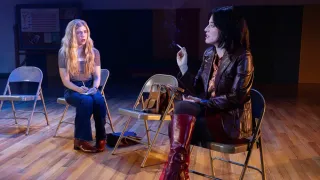March 11, 2018
In #MeToo Era, Some Question Need for 'Car Girls' at Shows
Jona Kallgren READ TIME: 2 MIN.
At the Geneva motor show, some automakers want visitors to focus their minds more on the models - the cars, that is, not the women.
In the wake of the #MeToo movement's explosion and growing awareness about sexual harassment, some auto executives have been taking a new look at the traditional use of often scantily-clad women on display stands at auto shows.
Some companies say a cultural shift is in the air. Though a walk through this year's Geneva auto show suggests the industry still actively associates its products with female sensuality and uses models to leverage that.
"I don't think we will be able to change the situation from one day to the next," said Susie Wolff, former development driver for the Williams racing team in Formula One, which has recently decided to stop using models at the start of competitions.
Wolff doesn't like the idea of women standing by merely to be objectified. "But I think we are making change in a positive way," said Wolff, who was at the show to promote an initiative to get more women involved in motorsports.
Leggy and heavily made-up models still adorn the stands at the Geneva show, though there seems to be a bit less skin on show than previous years.
"We never looked into optics, or whatever, when it comes to our presenters," said Rolls-Royce CEO Torsten Mueller-Oetvoes. "Our customers coming here expect from us that we can properly explain what our product is all about. And that is for me the more important thing."
Johan van Zyl, the head of Toyota Motor Europe, said his company isn't using women models to shape the image of the vehicles.
"It is all about explaining the product," van Zyl said. "Of course, models can also be utilized, but we don't want to make a derogatory type of display of females. It is not our company value and it is not what we want to be: Totally against it."
Neither Toyota nor Rolls-Royce had models standing by the cars, though they did have assistants - both women and men - dressed in business-wear to provide information to visitors.
Silvia Blattner, a spokeswoman for the Palexpo convention center that hosts the auto show, declined to wade in on the issue, saying in an e-mail that the motor show is a "neutral" platform for carmakers, which are free to decide how to present themselves.
Still, change comes hard - and not all companies are on board. The Skoda display for its Vision X featured a visit from the 2011 Miss Czech, Jitka Novackova, posing for cameras in a short dress and black leather boots rising over the knee. Automakers like Alfa Romeo and Ssangyong, among others, trotted out models, too.
"If I'm honest, I can sense very little difference in the way the car companies are using the women on their stands. There are still women draped on cars as we walk around the show," said Jim Holder, editorial director of Autocar.
"Really, is that acceptable in the modern world as a way to present your company?"
___
Jamey Keaten contributed to this report.






